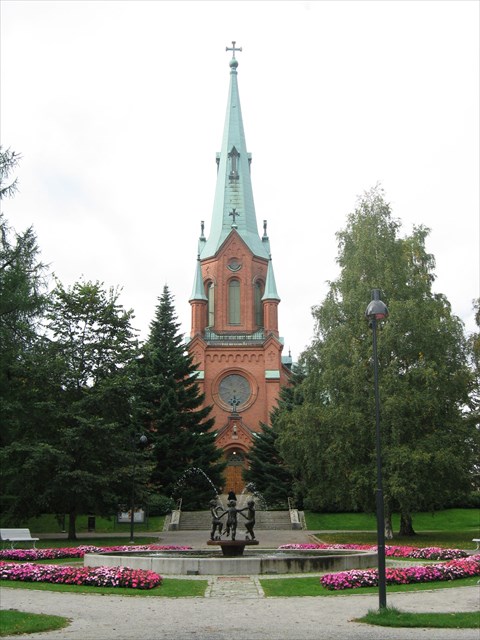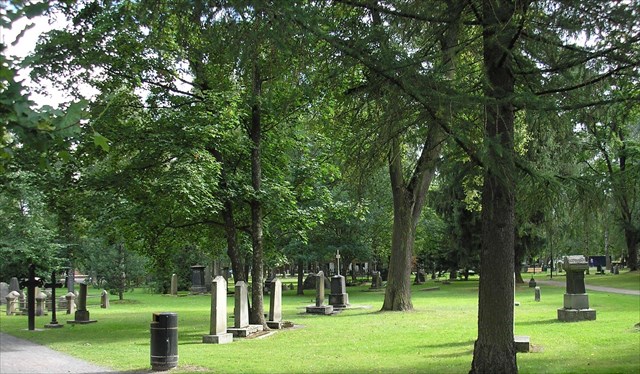Aleksanterin kirkko Traditional Cache
-
Difficulty:
-

-
Terrain:
-

Size:  (small)
(small)
Please note Use of geocaching.com services is subject to the terms and conditions
in our disclaimer.
Helppo tradi jästivilkkaalla paikalla Pyynikin kirkkopuistossa lähellä Aleksanterin kirkkoa.
Easy traditional cache in a muggle rich spot in Pyynikki church park near Alexander church.
Kätkö - Cache
Kätkö on sijoitettu itse kirkosta hieman sivuun, jottei se olisi aivan kaikkein vilkkaimmalla paikalla. Kirkko on annettu waypointtina. Noudata normaalia varovaisuutta jästien suhteen purkilla käydessäsi.
In English
The church is given as a waypoint in the cache description. Be careful when visiting the cache that you won't reveal it to muggles.
Aleksanterin kirkko
Aleksanterin kirkko on arkkitehti Theodor Deckerin suunnittelema ja se rakennettiin puhtaaksi muuratusta tiilestä vuosien 1880–1881 aikana. Se on nimetty keisari Aleksanteri II:n mukaan. Kirkkoa ympäröi Pyynikin kirkkopuisto.

Aleksanterin kirkko on päätytornillinen pitkäkirkko, jonka pitkiltä sivuilta erkanevat monikulmaisen kuoripäädyn kohdalla lyhyet ristinvarret. Kirkon julkisivua hallitsevat suuret pyöreät ja pyörökaariset ikkunat sekä ulkonevat pilarit, joilla ei kuitenkaan ole rakenteellista merkitystä vaan jotka ovat puhtaasti arkkitehtonisia koriste-elementtejä. Puulla katetun kolmilaivaisen kirkkosalin yläparvet on tuettu tiilipilarein. Mannermaista katedraalityyliä tavoitteleva kirkko edustaa myöhempää uusgoottilaista tyyliä, jossa on eri tyylisuuntien vaikutteita.
Kirkko vihittiin käyttöön adventtina 1881, jolloin siitä tuli Tampereen kaupunkiseurakunnan pääkirkko. Tulipalo tuhosi kirkon lähes kokonaan 1937, kun sen ensimmäinen peruskorjaus oli loppusuoralla. Työ kuitenkin saatettiin loppuun, ja korjaus valmistui joulukuussa 1938.
Kirkossa on istumapaikkoja 1 430. Kirkossa on 56+3-äänikertaiset Kangasalan urkutehtaan rakentamat sähköpneumaattiset urut vuodelta 1939. Alttaritaulun on maalannut Alexandra Frosterus-Såltin vuonna 1883, ja se on nimeltään Kristuksen kirkastus.
Lähde: Wikipedia
Pyynikin Kirkkopuisto
Pyynikin kirkkopuisto (vanhalta nimeltään Aleksanterin kirkkopuisto) on puisto Tampereen keskustassa Aleksanterin kirkon ympärillä ja länsipuolella. Alun perin paikalla sijaitsi vuonna 1785 perustettu Tampereen vanha hautausmaa, joka oli kaupungin ensimmäinen. Sen käyttö päättyi 1880-luvulla, kun Kalevankankaalle oli valmistunut uusi hautausmaa vuonna 1880. Samana vuonna hautausmaan ja Esplanadin väliin alettiin rakentaa Aleksanterin kirkkoa. Vaikka hautausmaa on ollut puistona jo yli sata vuotta, siellä on yhä jäljellä lukuisia vanhoja hautamuistomerkkejä.
 Kuva: Haltiamieli
Kuva: Haltiamieli
Sisällissodan aikana vuonna 1918 kirkon viereen on väitetty kaivetun joukkohauta, johon olisi haudattu teloitettuja punaisia. Haudat olisivat merkitsemättömiä ja niiden päällä kulkisi puistokäytäviä. Tieto ei kuitenkaan tutkijoiden mukaan pidä paikkaansa.
Puistossa kasvaa Suomen paksuin euroopanlehtikuusi, jonka ympärysmitaksi rinnankorkeudelta vuonna 1989 mitattiin 457 senttimetriä.
Lähde: Wikipedia
In English
Alexander Church
The church was named after Russian Emperor Alexander II because the foundation stone was laid on the day of his 25th anniversary in power, 2 March 1880. The church was consecrated during Advent in 1881.
Alexander Church became the main church of the Tampere parish when the construction work was completed in 1881, which had been the second basic condition for the independence of the parish. It was quickly dubbed the “New Church” among the people.
The first renovation of the church started in 1937, but a fire destroyed nearly everything when the work was all but finished. The renovation was taken up again immediately, and consequently the exterior was renewed, receiving its current appearance. The renovation was completed in December 1938.
Pyynikki Church Park
Pyynikin kirkkopuisto (Pyynikki Church Park) functioned as a cemetery from the year 1785 to the late 1880's. When the area was taken into use there was not yet a church in Tampere. Funerals were performed at a building located on the walk between the streets Koulukatu and Pirkankatu, and because of its location, the building was used as a passage through the cemetery. The Old Church was completed at Keskustori Square in 1824, and the neogothic Alexander Church - initially known as the "new church" - was built in the park in 1880.
In 1813 the first trees (birches) were planted in the park. Pyynikin kirkkopuisto - at the time called Aleksanterin kirkkopuisto (Alexander Church Park) - was planned by K. J. Gauffin, the first City Gardener of Tampere. White willow, Siberian larches and elms, for example, were planted in the park. During Gauffin's time, the first nursery garden was established at the Aleksanterin koulu school yard next to the park. A few trees and shrubs were grown in the nursery.
On the initiative of Onni Karsten, the second City Gardener, the renovation of Pyynikin kirkkopuisto was commenced in 1898. Thinning was carried out and new walks were constructed. Birches from the nearby nursery were planted on the extended area in the western part of the park. The maintenance of parks could be intensified when the first irrigation point in Tampere was installed in the park in 1902.
The thickest European larch (Larix decidua) in Finland (the girth was 457 cm at breast height in 1989) is in Pyynikin kirkkopuisto.
The fountain in the park was constructed in 1900. In connection with the fountain there is a statue named Kevät (Spring), which depicts happily dancing boys. The statue was sculpted by Rautalin in 1936.
Additional Hints
(Decrypt)
Chyggv, lyuääyyä
Obyg, hc
Treasures
You'll collect a digital Treasure from one of these collections when you find and log this geocache:

Loading Treasures